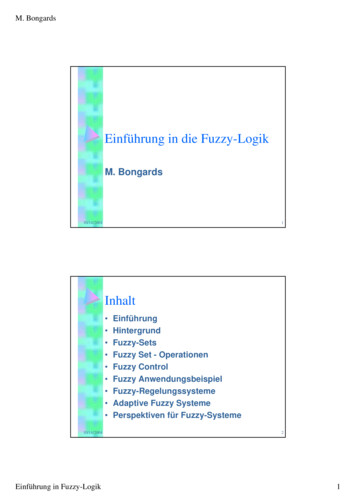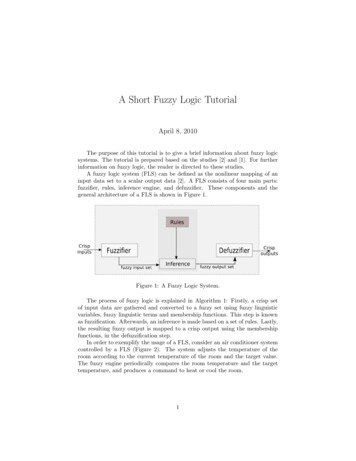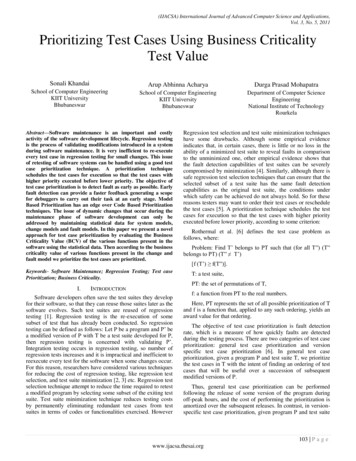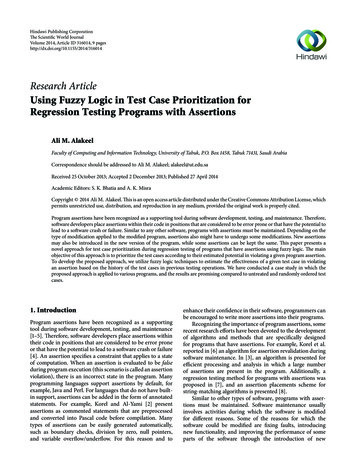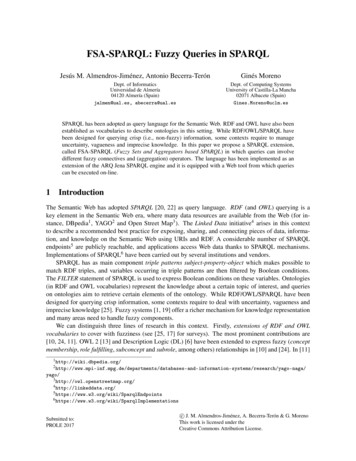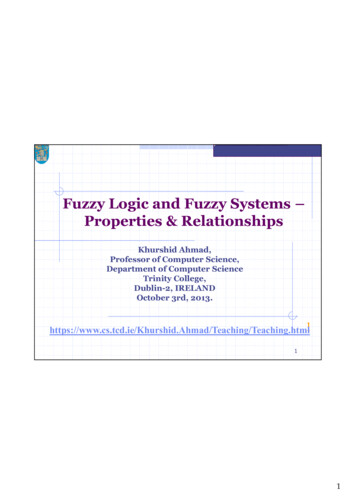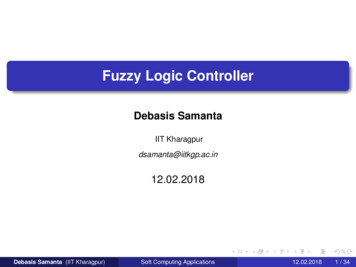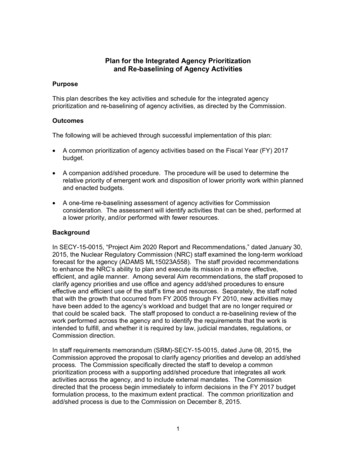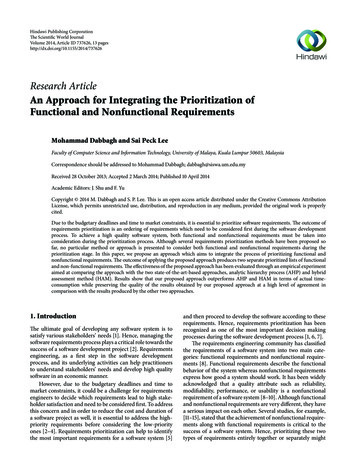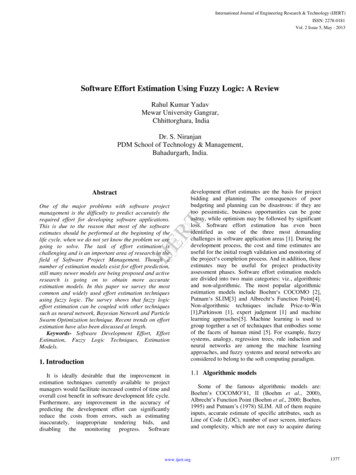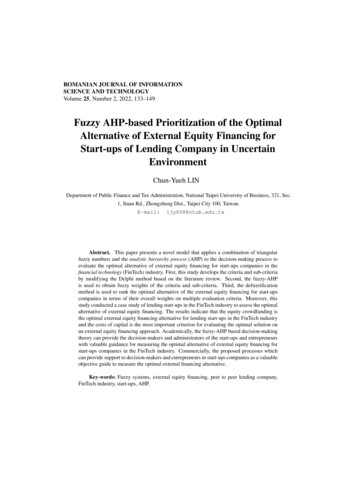
Transcription
ROMANIAN JOURNAL OF INFORMATIONSCIENCE AND TECHNOLOGYVolume 25, Number 2, 2022, 133–149Fuzzy AHP-based Prioritization of the OptimalAlternative of External Equity Financing forStart-ups of Lending Company in UncertainEnvironmentChun-Yueh LINDepartment of Public Finance and Tax Administration, National Taipei University of Business, 321, Sec.1, Jinan Rd., Zhongzheng Dist., Taipei City 100, TaiwanE-mail:ljy898@ntub.edu.twAbstract. This paper presents a novel model that applies a combination of triangularfuzzy numbers and the analytic hierarchy process (AHP) to the decision-making process toevaluate the optimal alternative of external equity financing for start-ups companies in thefinancial technology (FinTech) industry. First, this study develops the criteria and sub-criteriaby modifying the Delphi method based on the literature review. Second, the fuzzy-AHPis used to obtain fuzzy weights of the criteria and sub-criteria. Third, the defuzzificationmethod is used to rank the optimal alternative of the external equity financing for start-upscompanies in terms of their overall weights on multiple evaluation criteria. Moreover, thisstudy conducted a case study of lending start-ups in the FinTech industry to assess the optimalalternative of external equity financing. The results indicate that the equity crowdfunding isthe optimal external equity financing alternative for lending start-ups in the FinTech industryand the costs of capital is the most important criterion for evaluating the optimal solution onan external equity financing approach. Academically, the fuzzy-AHP based decision-makingtheory can provide the decision-makers and administrators of the start-ups and entrepreneurswith valuable guidance for measuring the optimal alternative of external equity financing forstart-ups companies in the FinTech industry. Commercially, the proposed processes whichcan provide support to decision-makers and entrepreneurs in start-ups companies as a valuableobjective guide to measure the optimal external financing alternative.Key-words: Fuzzy systems, external equity financing, peer to peer lending company,FinTech industry, start-ups, AHP.
1341.A. Chun-Yueh LINIntroductionThe Pecking Order Theory (POT) describes the sequence, as well as the alternatives, regarding the financing of start-ups. However, it is unable to account for the success of the financing ifsome factors come into play such as low funds, the corporations value, and the capability of financing. It does not work when the startup reaches the point where it has insufficient funds [1–3].From the review of the existing literature, there is a wealth of evidence indicating that contraryto theoretical predictions, start-ups will first approach private equity investors before seeking external debt financing [4, 5]. Yet, Vaznyte & Andries (2019) demonstrated that it remains unclearwhy certain start-ups follow the traditional pecking order [6]. Past studies have demonstrated thatthe availability of external financing is seen as being more beneficial to the development of smallfirms (start-ups), which usually face insufficient funds [7, 8]. Furthermore, Walthoff-Borm et al.(2018) proposed three external financing alternatives: angel financing (AF), equity crowdfunding(EC), and venture capital (VC) [9].In recent years, with the rise of financial technology (FinTech) in the global financial environment and implementation of Title III of the Jumpstart Our Business Start-ups (JOBS) Act in theUnited States, there has been an expansion in permissible equity crowdfunding [10]. Therefore,crowdfunding has emerged as a new relevant alternative for financing alongside more traditionalmeans of financing new ventures [11]. In 2014, the worldwide crowdfunding volume saw an impressive year-over-year jump of 167% to reach US 16.2 billion [12]. Furthermore, Statista Inc.(2019) indicated that the total transaction value in the alternative financing segment amounted toUS 11.7 million in 2019. The total transaction value is expected to show an annual growth rateof 14.3% between 2019 and 2023, resulting in a total value of US 20,000.2 million by 2023 [13].Crowdfunding is this market’s largest segment, with a total transaction value of US 6.9 billionin 2019. Thus, the crowdfunding market has grown rapidly during this period. Crowdfunding hasseveral different forms. (1) Donation-based crowdfunding involves collecting charitable fundingin support of causes and projects. (2) Rewards-based crowdfunding involves investors receivingnon-monetary rewards in exchange for their contribution. (3) Debt-based crowdfunding offers acredit contract between funders and fundraisers. (4) Equity-based crowdfunding offers an equitystake in the target company [14, 15].Angel financing investors, are private individuals investing directly in unlisted companies inwhich they have no family connections. Their investments have a significant economic impactand contribute to the survival of start-up firms [16, 17]. Past studies have shown that the size ofthe total angel investor market in the United States was US 24.6 billion in 2015, and the investment pool resulted in the creation of 270, 200 new jobs. Further, new ventures that attract AFfinancing exhibit higher survival rates, increased growth, more financing, more successful exits,and more employees compared with firms that cannot attract financing [18, 19]. The role of AFis important and, in some cases, essential for young ventures that require external financing [17].Thus, AF is also an important financing alternative for start-up enterprises.Another external equity financing alternative is equity crowdfunding. EC has emerged as anew financing alternative and plays an increasingly important role in financing start-up firms,as it provides new opportunities for entrepreneurs to target a broader group of external equityinvestors [20, 21]. The transactions cost will decrease by the use of social media, and EC introduces new mechanisms for entrepreneurs to establish a reputation with investors [22]. ECallows the matching of demand and supply in early-stage financing across a wide geographicalarea [23]. Furthermore, as traditional early-stage financing tends to be relational, its range andimpact are generally narrow and contain hidden biases [24]. Hence, EC is both an important
Fuzzy AHP-based Prioritization of the Optimal Alternative135alternative for start-up firms’ external equity financing and an early-stage financing alternativefor new enterprises [9, 25].Venture capital companies are a third equity financing alternative. Their critical activitiescomprise investment, support, exit, and reinvestment [26]. Generally, VC companies are equityholders that, in most instances, participate on the investee companies’ boards of directors. Theyhave the ability to guide and influence managerial decisions in terms of structure, operatingprocedure, and exit routes, including the decision to go public [27]. VC companies, as sourcesof external equity financing, positively affect firm performance by conducting post-investmentmonitoring and providing value-added services [28, 29]. Existing evidence demonstrates thatbusinesses receiving VC achieve significantly higher employment growth rates [30, 31], higherprofitability and R&D investment [32], and superior post-issue operating performance than thosethat receive no VC at all [33]. Consequently, VC is also an important financing alternative instart-up enterprises’ external financing activity.However, past studies do not provide theoretical insights or empirical evidence on how entrepreneurs or start-ups evaluate the optimal external equity financing alternative when choosingbetween crowdfunding and traditional external equity financing. In addition, the pecking ordertheory does not recognize how entrepreneurs choose between different sources of external equityfinancing, such as EC, AF, and VC [9]. The meaning is that start-ups or entrepreneurs of P2Plending companies for evaluating the optimal external equity financing alternative is a highlycomplex decision problem. Also, due to the strengths and weaknesses are different in externalequity financing alternatives (EC, AF, and VC) which implicit the characteristics of nonlinearand ambiguous in this decision issue. With regard to the “optimization” issue that has someapplications such as Beldjilali, et al. (2020) applied the optimization algorithm to construct asystem for resolving vehicle routing problems [34]. They indicated that the system can make itpossible for users to identify positions and track their vehicle fleet remotely via the web on anytype of device. Bojan-Dragos, et al. (2021) used the grey wolf optimizer algorithm to develop theoptimal fuzzy controllers for nonlinear issues to enhance the control system performance in electromagnetic actuated clutch systems [35]. The outcomes indicated that complex processes canbe improved efficiently by type-2 fuzzy controller. Pozna, et al. (2022) presented a hybrid metaheuristic optimization algorithm which combines particle filter and particle swarm optimizationalgorithms and implemented it for the optimal tuning of proportional-integral-fuzzy controllers[36]. The results showed that this combination can reduce the energy consumption of the fuzzycontrol system. The aim of this study was to use multi-criteria decision-making to evaluate theoptimal financing alternative for start-ups companies. The optimal concept in this study was different from the traditional optimization field (the cost/benefit function). Therefore, the optimalalternative concept of this work was concentrated on determining or obtaining suitable externalequity financing targets for start-ups companies. Due to start-ups being too young or the financialstructure is no good, external equity financing alternatives represent a potential target for startups to obtain capital. Based on the above, evaluating the optimal alternative selection was thecore concept of this research. Evaluation of the optimal alternative is a multi-criteria decisionmaking (MCDM) issue that is generally solved by applying the analytic hierarchy process (AHP)method to obtain the weights of each criterion, the sub-criteria and the alternatives [37]. Manystudies have employed AHP to construct a hierarchy model that can structure MCDM researchissues [38–40]. Even though AHP is popular, this methodology cannot adequately resolve the inherent uncertainties and imprecisions associated with mapping the decision maker’s perceptionsinto exact numbers [37, 41]. Hence, many previous works have combined the fuzzy set theory
136A. Chun-Yueh LINwith AHP to solve uncertain and ambiguous issues [42–46]. Furthermore, the uncertain andvague expert opinions result in more complications, making it quite challenging to quantitativelypredict the given problems, as compared to the use of qualitative prediction [47, 48]. In such acase, the fuzzy-AHP framework can assist in translating the qualitative expressions of human beings into meaningful numeric predictions [49]. Khan et al. (2019) indicated that the fuzzy-AHPframework has been utilized to rate human-opinion based optimal alternative selection problems[48]. Consequently, this study constructed a fuzzy-AHP based evaluation framework for fuzzyprioritization, in which expert comparison judgments are represented by fuzzy triangular numbers. Fuzzy-AHP was applied as the evaluation method in this study, and its effectiveness wasillustrated by numerical examples. In addition to a literature review and survey of experts in thefinancial field, this study implemented the modified Delphi method and fuzzy-AHP to establishan evaluation process for estimating the optimal financing alternative for start-ups companies inthe FinTech industry.Therefore, this study integrated the fuzzy algorithm and AHP to construct an evaluationmodel for assessing the synthetic utility values of the criteria and sub-criteria of the optimalexternal equity financing alternatives, and then assigned a suitable relative weight to each criterion within the fuzzy hierarchical framework to rank the optimal external financing alternative.Academically, the fuzzy-AHP based decision-making theory could provide the entrepreneursand the decision makers and administrators of start-ups s with valuable guidance for measuring the optimal external financing alternative start-ups of companies in the FinTech industry.Commercially, the proposed evaluation model could provide support to decision-makers and entrepreneurs of start-ups companies as a valuable objective guide to measure the optimal externalfinancing alternative.2.Evaluation modelThe modified Delphi method was utilized to collect expert opinions, recognize the determinants of the evaluation framework, and obtain the weighted criteria and ranking using fuzzy-AHP.This evaluation model was based on the research of Lin (2020) and was used to solve the newresearch field and investigate such as new perspectives, sub-criteria, and different alternativesin the crowdfunding issue to obtain the optimal external financing alternative for start-ups companies [41]. The Delphi method, AHP algorithm, and fuzzy-AHP method are described in thefollowing sections.2.1.Delphi methodThe Delphi method comprises several rounds of expert interviews regarding the inquiries,feedback, and arguments of previous rounds, during which the topics may change and the responses remain anonymous [50]. This method is especially suitable for explorative studies wherechanges in the relations between critical variables are intuitively expected, the respondents aregeographically distant, and there is no dominating person in the discussion [51, 52]. This studyimplemented the Delphi method, and the results were statistically valid. The procedure wasbased on the works of Sung (2001), Wu, et al. (2007) and Lin (2020) [41, 53, 54].
Fuzzy AHP-based Prioritization of the Optimal Alternative2.2.137AHP methodSaaty (1980) proposed the AHP model to solve complex decision problems [55]. Thisdecision-making method deconstructs a complex MCDM problem into a hierarchy [56]. TheAHP steps of this study were based on the study of Lin (2020) [41].2.3.Fuzzy AHP methodThe advantages of the developed fuzzy theory model facilitate its use in real-life situations formaking effective decisions [57, 64]. Some study results have presented the combined applicationof the fuzzy set theory with AHP in areas such, performance evaluation, green supplier selection,Internet of Things evaluation, the impact of offshore outsourcing location prediction, shortestpath problems, software selection, and reverse logistics evaluation [42, 46, 58, 59] Additionally,Kwak, et al. (2021) proposed a model to check the reductive property using the fuzzy modusponens and fuzzy modus tollens in moving distance fields [60]. The results of the experimentsshowed that the proposed model is simple and effective for human thinking. Pozna and Precup(2014) developed a new framework implementing the fuzzy signatures rule with expert systemmodelling and applied the knowledge base and the data base as inputs to construct the expertsystems [61]. The results illustrated that the algorithm is advantageous in the systematic andgeneral formulation and allows for the building of uncertain expert systems. Hedrea, et al., (2021)developed an architecture for the nonlinear concept of a Tower CRrane (TCR) system through thetensor product (TP)-based model transformation algorithm [62]. The results indicated that testedtwo scenarios and its performance of TP model which can provide the other dynamic systemsmodelling applications a valuable guideline.In this study, triangular fuzzy numbers (TFNs) were used to present the preferences of onecriterion over another according to the literature of Lin (2020) and Lu and Zhu (2018); however,the TFNs of this study represented a different application from that of Lu and Zhu (2018) [41,63]. The structure of the TFNs is shown in Figure 1, and the membership function is shownin Table 1. This study employed fuzzy-AHP to conduct fuzzy hierarchical analysis by allowingTFNs for pair-wise comparisons and calculating the fuzzy preference-weights. The procedure offuzzy-AHP algorithm was based on the work of Lin (2020) and the evaluation processes were asfollows [41].Fig. 1. Feature extraction process.
138A. Chun-Yueh LINTable 1. Membership function of linguistic scaleFuzzynumber987654321Linguistic scalePerfectAbsoluteVery goodFairly goodGoodPreferableNot badWeak advantageEqualScaleof triangularfuzzy 4,5)(2,3,4)(1,2,3)(1,1,2)Scaleof triangularfuzzy )(1/3,1/2,1)(1,1,1)Source: [80,81]Step 1: Establish the problem and modelThe problem should be clearly declared and decomposed into a rational system such as anetwork. The structure can be obtained according to the opinion of the decision makers throughthe modified Delphi method, brainstorming or other appropriate methods.This study collected the sub-criteria, based on a literature review and expert interviews, andused a 7-point Likert scale for scoring, with answers ranging from very important (7) to veryunimportant (1). After obtaining the scores, consistency testing was conducted using quartiledeviation to sort the criteria.Step 2: Establish the TFNsAs each number in the pair-wise comparison matrix indicates the subjective opinion of decision makers and is an ambiguous concept, fuzzy numbers work best for consolidating fragmentedexpert opinions through TFNs and the membership function of the linguistic scale (see Table 1).The TFNs ueij can be obtained using the formula of Lin (2020) [41].Step 3: Establish the fuzzy pair-wise comparison matrixSaaty (1980) argued that the geometric mean accurately represents the consensus of experts,and it has become widely used in practical applications. In this study, the geometric mean methodwas used as the model for the TFNs [54].According to expert opinion and linguistic scale transformation, construct the TFNs of nfuijand develop the fuzzy pair-wise comparison matrix across nfuij . The definition of the fuzzy pairwise comparison matrix can be obtained by the formula from Lin (2020) and include the nugij ,] ]LL,MMandUU[41].ijijijStep 4: Computation of the fuzzy weightsfi ) in Lin (2020) can be calculated [41].In the light of the fuzzy weights (WStep 5: DefuzzificationThe defuzzification process was according to the literature of Lin (2020). DFi can be obfi [41].tained by WStep 6: NormalizationAs the summation of the defuzzification weights of each criterion is not equal to 1, it isnecessary to normalize the defuzzification weights to a new weight (NW). N Wi refers to theweight of fuzzy-AHP in each criterion, which can be obtained by the literature of Lin (2020) [41].
Fuzzy AHP-based Prioritization of the Optimal Alternative139Step 7: Rank the fuzzy-AHP weightsA set of alternatives can be ranked according to the descending order of NWi. The aim ofthis work was to integrate the fuzzy algorithm and AHP for assessing the synthetic utility valuesof the criteria and sub-criteria of the optimal external financing alternative and then, assign asuitable relative weight to each criterion within the fuzzy hierarchical framework to rank theoptimal external financing alternative for start-ups companies in the Fintech industry. Section 3presents an application of the proposed model using the above steps.3.Empirical studyThis study constructed indicators to evaluate the optimal external financing alternative forstart-ups companies in the FinTech industry. The research framework is illustrated in Figure 2.An evaluation framework was constructed based on the modified Delphi method to assess theabovementioned optimal external financing alternatives using the fuzzy-AHP methodology. Theproposed framework for evaluating the optimal external equity financing alternative comprise thefollowing processes.Fig. 2. The research framework of optimal alternative on external equity financing for lendingcompany start-ups in the FinTech industry.Step 1: Establish the problem and modelAccording to the literature review, a general consensus needed to be reached by the expertsto establish a research model [65, 66]. Using the research model, this study obtained the finalevaluation target of optimal external equity financing alternative for start-ups companies, alongwith three evaluation criteria, 11 sub-criteria, and the final external equity financing alternatives(Figure 2).The evaluation criteria and sub-criteria that were applied to determine the optimal externalequity financing alternative for start-ups companies in the FinTech industry are defined as follows:
140A. Chun-Yueh LIN1. Finance perspective:1.1. Level of loan [20, 67]: This refers to the level of loan from different external equity financing alternatives such as angel financing, equity crowdfunding, and venturecapital.1.2. Dispersion of equity [20, 68, 69]: This refers to the dispersion of equity by the investor, such as that through angel financing, equity crowdfunding, and venture capital.1.3. Cost of capital: This refers to the cost of capital, fees, human capital, advertisement,interest rates, and so on from different external financing alternatives.2. Operational perspective:2.1. Number of board members [68, 70]: This refers to the degree of intervention by theangel financing, equity crowdfunding, or venture capital investors in start-up firms.2.2. Effect of start-ups exposure [71, 72]: A start-up’s reputation can be improved byusing different external financing alternatives, such as angel financing, equity crowdfunding, and venture capital.2.3. Degree of difficulty in capital obtaining [67]: The degree of difficulty in obtainingcapital is not consistent since the characteristics of the external financing alternativesare not the same.2.4. Implementation of experts and resources [73, 74]: This considers the investors’ policies when using angel financing, equity crowdfunding, or venture capital during theimplementation of experts and resources.3. Risk perspective:3.1. Plagiarism [75]: A start-up’s know-how or ideas can be plagiarized by an externalcrowdfunding platform.3.2. Business culture [76, 77]: Investors may affect a start-up’s operational environmentand culture, which could create conflict with the start-ups.3.3. Limitation [69, 78, 79]: Investors may intervene in a start-up’s control and liquidationpreferences and present terms restricting the founders when providing capital to thestart-up.3.4. Degree of complexity in crowdfunding [67]: The degree of complexity is differentwhen crowdfunding uses different external crowdfunding approaches. Therefore, theinfluence of the financing activity is very strong for start-up firms during early-stagefinancing.4. External Equity Financing Alternatives4.1. Equity crowdfunding: Equity-based crowdfunding offers an equity stake in the targetcompany.4.2. Angel financing: AF investors are private individuals who directly invest in unlistedcompanies in which they have no family connections. Their investments have a significant economic impact and contribute to the survival of the start-up firms.
141Fuzzy AHP-based Prioritization of the Optimal Alternative4.3. Venture capital: VC firms are equity holders and, in most instances, participate onthe investee companies’ board of directors. Moreover, they have the ability to guideand influence managerial decisions in terms of the company’s structure, operatingprocedure, and exit routes, including the decision to go public.Step 2: Establish the TFNsThis study established the TFNs (see Figure 1) of each pair-wise comparison from the resultsof the AHP questionnaires through the fuzzy linguistic scale, and then, established the TFNsaccording to the literature of Lin (2020). Table 2 lists the results of the AHP questionnaire, whichwere used to obtain the pair-wise comparison matrix in the Tier 1. Next, this study implementedthe fuzzy linguistic scale to calculate the fuzzy pair-wise comparison matrix (Table 3). Theoutcomes of the TFNs are shown in Table 2–7 and include Tier 1 to Tier 3.Table 2. The pair-wise comparison matrix of the goal with le 3. The fuzzy linguistic scale of the goal with criteriaGoalFinanceOperationRiskFinance(1.000 1.000 1.000)(0.191 0.237 0.315)(0.481 0.630 1.260)Operation(3.175 4.217 5.241)(1.000 1.000 1.000)(2.464 3.632 4.715)Risk(0.794 1.587 2.080)(0.212 0.275 0.406)(1.000 1.000 1.000)Table 4. The pair-wise comparison matrix of finance criterion with sub-criteriaFinanceLevel of loanDispersion of equityCosts of capitalCosts of capitalLevel of loan1.0000.4373.922Dispersion of equity2.2891.0005.181Costs of capital0.2550.1931.000Table 5. The fuzzy linguistic scale of finance criterion with sub-criteriaFinanceLevel of loanDispersion of equityCosts of capitalLevel of loan(1.000 1.000 1.000)(0.303 0.437 0.794)(2.886 3.916 4.934)Dispersion of equity(1.260 2.289 3.302)(1.000 1.000 1.000)(4.159 5.191 6.213)Costs of capital(0.203 0.255 0.347)(0.161 0.193 0.240)(1.000 1.000 1.000)Step 3: Establish the fuzzy pair-wise comparison matrix The fuzzy pair-wise comparisone was determined by the literature of Lin (2020) [41]. The results of the level of “Goal”matrix (A)and criterion of “Finance” are as shown a sample. Table 8 shows the fuzzy pair-wise comparisonmatrix in the level of “Goal” and “Finance”. Table 9 shows a sample of the results of the level ofloan criterion in three alternatives.
142A. Chun-Yueh LINTable 6. The pair-wise comparison matrix of sub-criterion of the level of loan with alternativesLevel of loanEquity-crowdfundingAngel fundVenture capitalEquitycrowdfunding1.0000.3470.265Angel fundVenture capital2.8841.0000.4373.7802.2891.000Table 7. The fuzzy linguistic scale of sub-criterion of the level of loan with alternativesLevel of loanEquity-crowdfundingAngel fundVenture capitalEquity-crowdfunding(1.000 1.000 1.000)(0.232 0.347 0.550)(0.207 0.265 0.368)Angel fund(1.817 2.884 4.309)(1.000 1.000 1.000)(0.303 0.437 0.794)Venture capital(2.714 3.780 4.820)(1.260 2.289 3.302)(1.000 1.000 1.000)Table 8. The fuzzy pair-wise comparison matrix of criteria and sub-criteriaFinanceOperationRiskLevel of loanDispersion of equityCosts of capitalGoalFinanceOperation1.000 1.000 1.0003.175 4.217 5.2410.191 0.237 0.3151.000 1.000 1.0000.481 0.630 1.2602.464 3.632 4.715FinanceLevel of loanDispersion of equity1.000 1.000 1.000 1.260 2.289 3.3020.303 0.437 0.7941.000 1.000 1.0002.886 3.916 4.9344.159 5.191 6.213Risk0.794 1.587 2.0800.212 0.275 0.4061.000 1.000 1.000Costs of capital0.203 0.255 0.3470.161 0.193 0.2401.000 1.000 1.000Table 9. The fuzzy pair-wise comparison matrix of alternativesEquity-crowdfundingAngel fundVenture capitalLevel of LoanEquity-crowdfundingAngel fund1.000 1.000 1.0001.817 2.884 4.3090.232 0.347 0.5501.000 1.000 1.0000.207 0.265 0.3680.303 0.437 0.794Venture capital2.714 3.780 4.8201.260 2.289 3.3021.000 1.000 1.000Step 4: Computation of the fuzzy weights The fuzzy weights (Wi ) and real weights inthis step were evaluated according to the research of Lin (2020) [41]. Table 10 shows a sampleof the results for each tier of the fuzzy weights and real weights in the criteria, sub-criteria, andalternatives.Step 5: DefuzzificationAfter computing the fuzzy weights, the defuzzification process was performed according theresearch of the Lin (2020) to estimate the real weights [41]. Defuzzification was performedon the samples of perspective of Finance and sub-criterion of level of loan to calculate the realweights (see Table 10).Step 6: NormalizationThe summation of the defuzzified weights was not equal to one in the same hierarchy; hence,the defuzzification weights were normalized by Eq. (1) to obtain the new weights, as follows: :
143Fuzzy AHP-based Prioritization of the Optimal AlternativeTable 10. The fuzzy weights and real weights of all criteria and sub-criteriaGoalFinanceOperationRiskFinanceLevel of loanDispersion of equityCosts of capitalLevel of loanEquity-crowdfundingAngel fundVenture capitalGoal(N Wi ) Fuzzy weightsLLMMUU0.300 0.523 0.8030.076 0.112 0.1820.233 0.366 0.656LLMMUU0.134 0.209 0.3180.077 0.109 0.1750.482 0.682 0.951LLMMUU0.367 0.611 0.9950.143 0.255 0.4420.086 0.134 0.240Real 53F inance 0.5420.542 0.123 0.418 0.501Opertion 0.1230.542 0.123 0.418 0.113Risk 0.4180.542 0.123 0.418(1) 0.386The N Wi of all criteria and sub-criteria are shown in Table 11.Step 7: Rank the fuzzy-AHP weightsThe normalization of the fuzzy-AHP weights was used to rank the sequence of the results(see Table 12). The sequence of the alternatives of three external equity financing for start-upscompanies in the Fintech industry was EC (0.482) AF (0.378) VC (0.140). On the otherhand, the fuzzy-AHP value of the perspective and sub-criteria were as follows: finance (0.501);operation (0.113); risk (0.386); level of loan (0.211); dispersion of equity (0.115); costs of capital(0.674); number of board members (0.009); effect of start-ups exposure (0.031); degree of difficulty in capital obtaining (0.067); implementation of experts and resources (0.016); plagiarism(0.064); business culture (0.031); limitation (0.227); and degree of complexity in crowdfunding(0.129). The sequential weights of the three perspective and 11 sub-criteria were ranked as costsof capital limitation degree of complexity in crowdfunding level of loan degree ofdifficulty in capital obtaining plagiarism dispersion of equity effect of start-ups exposure business culture implementation of experts and resources number of board members.Therefore, the rank of this study showed that the sequential weights of three sub-cri
by modifying the Delphi method based on the literature review. Second, the fuzzy-AHP . possible for users to identify positions and track their vehicle fleet remotely via the web on any type of device. Bojan-Dragos, et al. (2021) used the grey wolf optimizer algorithm to develop the . monitoring, American Economic Review 91(2), pp. 426 .
